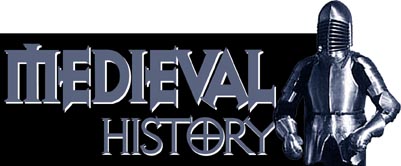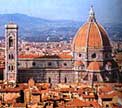Highlands Ranch High School - Mr. Sedivy
Highlands Ranch, Colorado

-
World History -
High Middle Ages / National Monarchies
Agricultural Revolution
New inventions (heavy plow, water wheel, windmill). The horse collar
let horses do the work. Horses are faster and have more stamina
than oxen - the old yokes choked horses. New inventions increase
the food supply, increasing the population. Now, there were not
as many serfs.
Trade and Commerce
The increase in population meant an increase in trade. Trade was
mostly controlled by Italian city states of Milan, Venice, and Florence.
There were new business methods: merchants pooled resources to finance
large-scale trading. Moneychangers led to banking. They had "strong
boxes," the people thought it was safe, and moneychangers would
lend out money. This led to an increase in banking and guilds. There
was growth of towns and cities because of more trade and the greater
food supply.
Middle Class
The Middle Class grew because now there was a new group of people
who were not tied to the land. They had no obligations to a lord.
This led to an increase in specialized trade. The middle class grew
quickly and prospered.


Left: Medieval Illuminated Manuscript.
Right: Artists at work at a manuscript and a panel painting.
From the pattern book of the Reun Monastery - 1200.
Before the printing press, books were copied and decorated by hand.
Universities
The increase in population and increase in trade led to a revival
in learning. Universities developed as young men went to study with
renowned scholars. University curriculum was based on the study
of translations of Latin and Greek words.
Strong National Monarchies

England
England now had stronger kings with centralized authority. England
became the first truly unified state under William the Conqueror.
In 1066 he brought the Normans, descendents of the Vikings, across
and conquered Harold, the Saxon King.

Scene from the Bayeux Tapestry 1066.
The tapestry is the historical record of William the Conqueror.
Click the tapestry to view the entire
Bayeux Tapestry.
Twenty years after the Norman Conquest, William the
Conqueror ordered a great survey of property owners in England.
This was called the "Domesday Book" (or doomsday), because
it spared no one and there was no appeal. William wanted to find
out how much land people held so that he could be sure that he was
getting all the taxes that were due him. The doomsday book recorded
who owned land, how much land they owned, how many people worked
the land, how many animals they owned, and how many pastures, mills,
and fish ponds they had. The survey was completed in 1086.

The Domesday Book can be seen at the Public Record
Office in London.
Magna Charta (1215)
English Lords forced King John to grant them certain rights, including:
Taxation with representation.
 Trial
by a jury.
Trial
by a jury.
 The
king had to rule according to law. These rights only applied to
the lords, only one-sixth of the population.
The
king had to rule according to law. These rights only applied to
the lords, only one-sixth of the population.

France
King Philip II established power over the French lords in 1202 by
beating King John of England and taking his land. Louis IX (St.
Louis is named for him) established a uniform code of laws for all
of France, 1226 - 1270.

Aware of his position as spiritual and political
leader of France,
Louis IX guarded his royal prerogatives in his dealings with the
bishops.
Italy and Germany
Italy and Germany both remained divided. In Italy, the Pope, various
city-states, and local rulers divided power. In Germany, power was
shared by numerous princes.
Back to Top of Page



![]() 9375 South Cresthill Lane
9375 South Cresthill Lane ![]() Highlands Ranch, Colorado 80126
Highlands Ranch, Colorado 80126 ![]() 303-471-7000
303-471-7000





